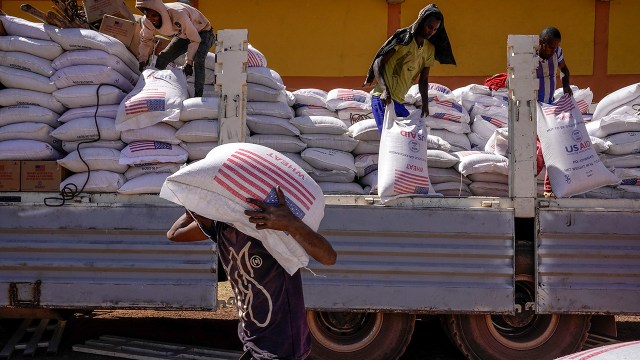
The Trump administration’s recent moves to freeze foreign aid and shutter the primary agency that distributes it have thrown a spotlight on a relatively small, yet enduringly controversial, piece of federal spending. The actions have created uncertainty among aid groups and governments around the world about what programs can and cannot proceed.
With that in mind, Pew Research Center dug into federal data and our own previous survey work for relevant facts and figures about the U.S. government’s aid efforts, as well as public attitudes toward them. Find answers to some common questions about U.S. foreign aid, including:
- How much does the federal government spend on foreign aid?
- How big is foreign aid as a share of the entire federal budget?
- What is U.S. foreign aid money used for?
- Who receives U.S. foreign aid?
- Who distributes U.S. foreign aid?
- What about military assistance?
- How do Americans feel about foreign aid?
How much does the federal government spend on foreign aid?
The government is currently on track to spend about $58.4 billion on international assistance programs in the 2025 fiscal year, according to January 2025 projections from the Congressional Budget Office. But since we’re only four months into the fiscal year, and the Trump administration is moving aggressively to reshape and reduce aid, that figure may change.
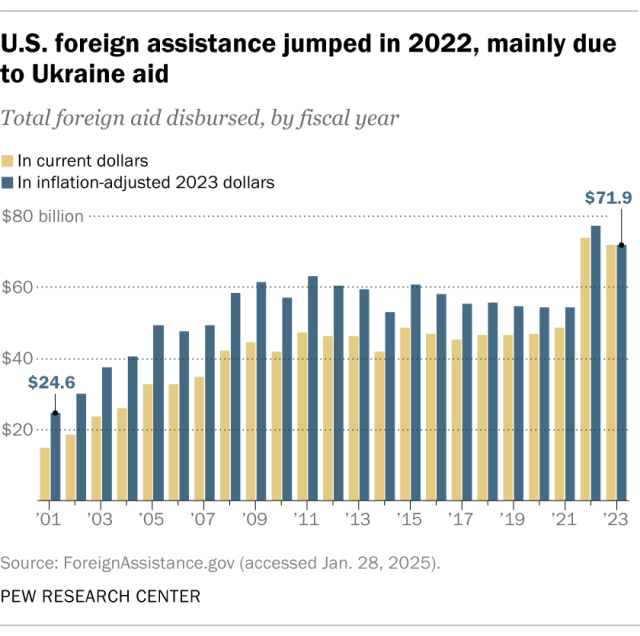
In fiscal 2023, the most recent fiscal year for which data is largely complete, the U.S. government disbursed $71.9 billion in foreign aid, according to ForeignAssistance.gov. That compares with nearly $74.0 billion spent in fiscal 2022. These figures (and others from ForeignAssistance.gov) do not include most arms sales or transfers of military equipment to foreign countries.
The amount, recipients and uses of foreign aid shift from year to year, depending on changing circumstances (such as wars, disasters or disease outbreaks) and evolving policy priorities. For example, U.S. foreign aid spending was much lower, comparatively, in fiscal 2001: $24.6 billion in inflation-adjusted 2023 dollars. But by federal budgetary standards, annual aid spending in recent years hasn’t varied all that much. Between fiscal 2008 and fiscal 2023, annual aid spending ranged from $52.9 billion to $77.3 billion, adjusted for inflation.
The U.S. government is the single-largest aid donor in the world, according to the United Nations, accounting for more than 40% of all humanitarian aid the UN tracked in 2024.
How big is foreign aid as a share of the entire federal budget?
The $71.9 billion in foreign aid that the government spent in fiscal 2023 works out to 1.2% of that year’s total federal outlays, which were more than $6.1 trillion.
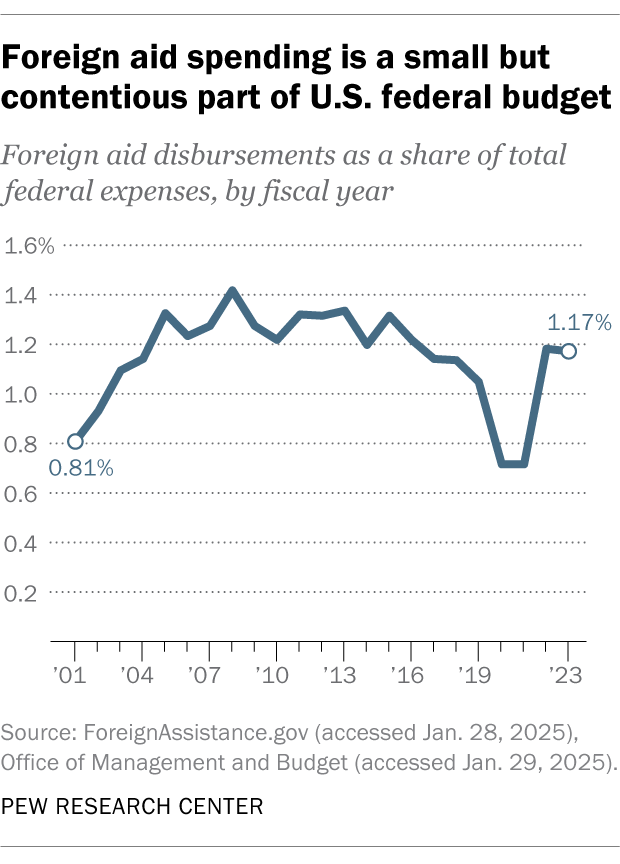
Since fiscal 2001, foreign aid has ranged between 0.7% and 1.4% of total federal outlays. For context, the federal deficit – the gap between receipts and expenditures that has to be bridged by borrowing – was nearly $1.7 trillion in fiscal 2023.
Foreign aid was a bigger share of federal spending at the height of the Cold War. In fact, the modern aid system was very much a product of the U.S.-Soviet rivalry.
In fiscal 1963, international assistance amounted to about 4.7% of total federal outlays, according to archived data from the Office of Management and Budget (OMB). But the share steadily fell as the Cold War ground on, bottoming at 0.6% of total outlays in fiscal 1989. (The OMB figures are slightly different from the ones on ForeignAssistance.gov due to differing methodologies, though the overall trend remains the same.)
What is U.S. foreign aid money used for?
U.S. foreign assistance supports a wide variety of humanitarian, economic development and democracy-promotion efforts, although the categories can be somewhat opaque and the lines between them blurry.
For instance, the biggest activity area in fiscal 2023, at $15.9 billion or 22.1% of all disbursed aid, was “macroeconomic foundation for growth.” That may sound like it all went for economic development, but $14.4 billion of that total was direct monetary support to the Ukrainian government in its war with Russia.
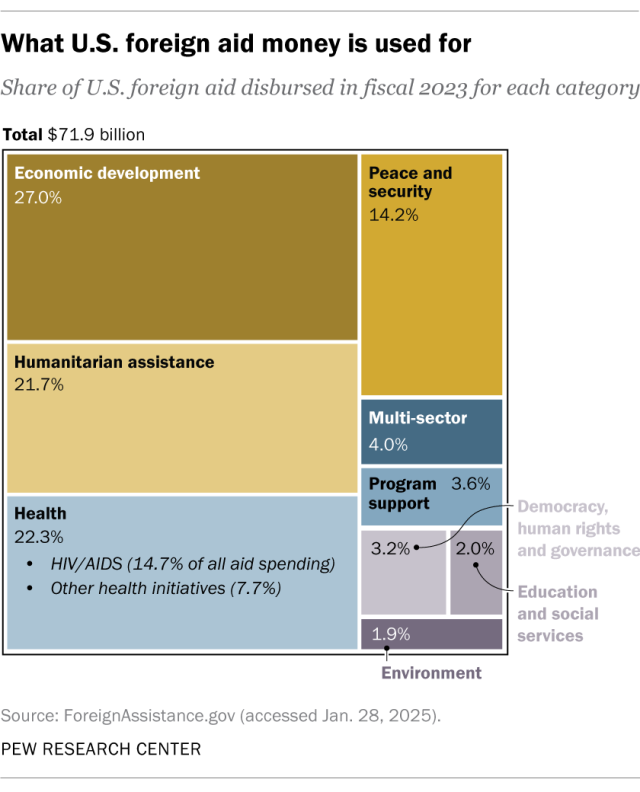
U.S. foreign aid also went toward:
- Disaster relief and other humanitarian aid ($15.6 billion, or 21.7% of total aid disbursements in fiscal 2023)
- Efforts to solve the ongoing battle against HIV/AIDS ($10.6 billion, or 14.7%)
- Combatting “pandemic influenza” and other emerging public health threats ($1.5 billion, or 2.0%)
- Promoting democracy, good governance and the rule of law ($2.3 billion, or 3.2%)
- “Multi-sector” programs that crossed several subject areas ($2.9 billion, or 4.0%)
Who receives U.S. foreign aid?
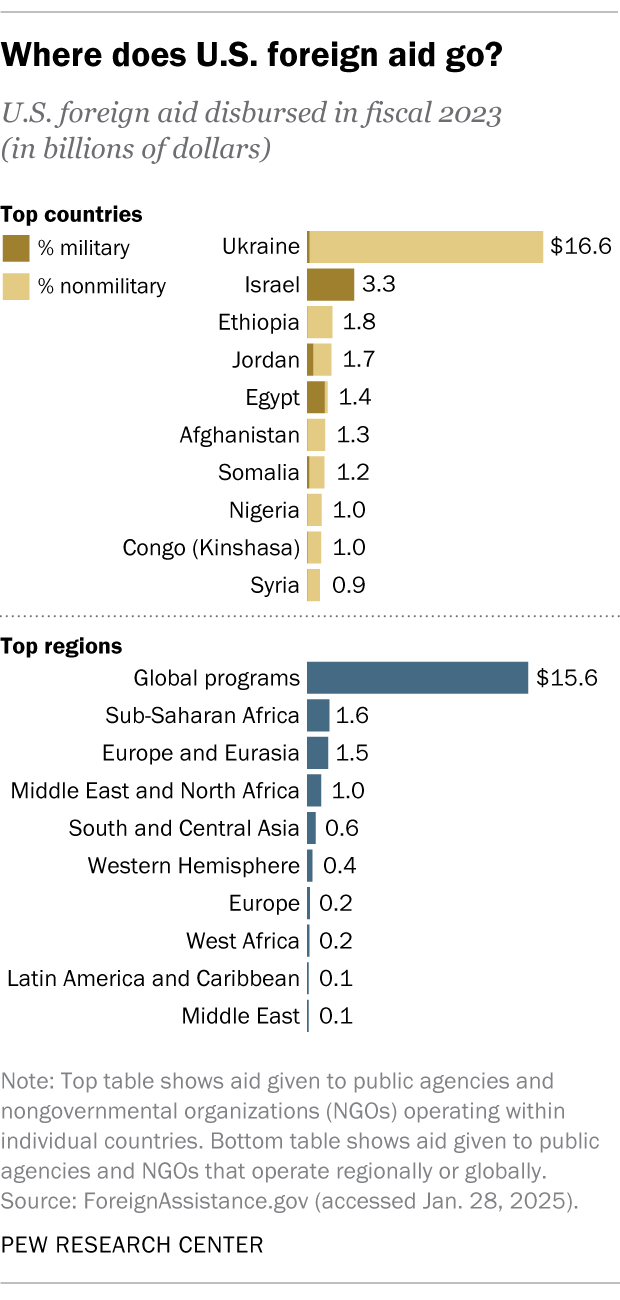
In fiscal 2023, U.S. aid dollars supported programs and activities in 177 individual countries and 29 regions. They also helped fund global endeavors. The individual projects were carried out by a wide range of foreign government agencies, nonprofit groups, international organizations and for-profit companies and universities, numbering in the thousands globally.
Ukraine was the single-biggest recipient of U.S. aid in fiscal 2023, receiving $16.6 billion to help it fend off Russia’s invasion and keep its government and society running. Israel, regularly one of the top aid recipients, got $3.3 billion in military aid in fiscal 2023, on par with recent years. Other major recipients included Ethiopia, Jordan, Egypt and Afghanistan.
Who distributes U.S. foreign aid?
Since it was created in 1961, the United States’ primary aid agency has been the U.S. Agency for International Development (USAID). As of March 2024, according to the FedScope database, USAID employed 4,675 people, many of them overseas. In fiscal 2023, USAID distributed nearly $43.8 billion in aid, about three of every five foreign-assistance dollars. Starting in late January, however, the Trump administration began trying to dismantle USAID by laying off most of its employees, pausing many of its funding activities and moving those that remain inside the State Department.
The State Department disbursed $21.3 billion in aid in fiscal 2023, almost 30% of the total. Smaller amounts were disbursed by the Treasury and Health and Human Services departments, the Millennium Challenge Corporation, and 16 other agencies.
What about military assistance?
Only $8.2 billion of the $71.9 billion in disbursements in fiscal 2023 (11.4%) was designated as military aid, according to ForeignAssistance.gov. But the United States’ overall military-assistance efforts are much bigger than that.
Through the Foreign Military Sales program, approved foreign nations can buy American weapons, ammunition, equipment and services, with the U.S. government acting as a broker or intermediary (and sometimes with government financing). In fiscal 2024, such sales totaled $117.9 billion, up from $80.9 billion in fiscal 2023, according to the State Department.
Allies and partner nations can also buy arms from their manufacturers on their own, without U.S. government involvement. However, such “direct commercial sales” are regulated by law as to who can buy arms, from whom they can be bought, and what weapons are allowed to be exported. Direct commercial sales totaled $200.8 billion in fiscal 2024, up from $157.5 billion in fiscal 2023.
How do Americans feel about foreign aid?
For many years, Americans have had, at best, mixed views about the effectiveness and desirability of foreign assistance.
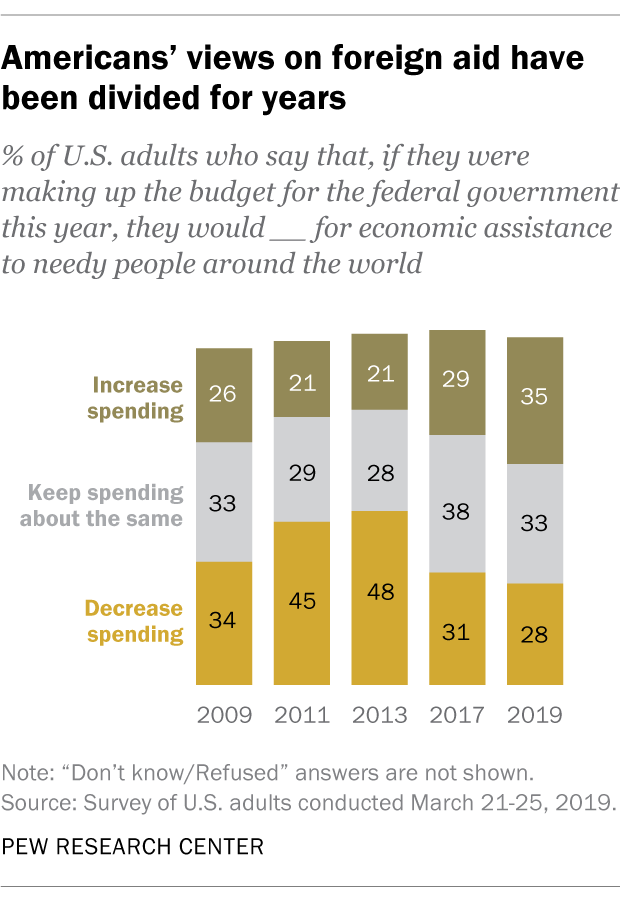
Pew Research Center surveys on federal spending have long found split opinions on “economic assistance to needy people around the world.” The most recent such work, a 2019 telephone survey, found that 35% of U.S. adults wanted to increase spending on such aid, 33% wanted to keep it the same, and 28% wanted to decrease it.
More recently, in a March 2023 survey conducted online, only a third of Americans said U.S. foreign aid mostly benefits developing countries, while slightly more (37%) said such aid both benefits and harms these countries, and 8% said it mostly harms developing countries. A fairly large share (17%) said they weren’t sure.
When it comes to Americans’ foreign policy goals more broadly, the public places far more emphasis on certain priorities, especially ones related to domestic security.
For instance, 73% of U.S. adults said in a 2024 online survey that taking measures to protect the country from terrorist attacks should be a top priority of U.S. long-range foreign policy. Almost two-thirds (64%) said reducing the flow of illegal drugs into the country should be a top priority – about as many as cited preventing the spread of weapons of mass destruction. And 52% said reducing the spread of infectious diseases should be a top priority.
Conversely, only 26% of Americans said that promoting and defending human rights in other countries should be a top priority, and even fewer (18%) said that about promoting democracy in other nations.
U.S. foreign aid money goes toward many of those same priorities. For instance, in fiscal 2023, $417.8 million went to counterterrorism efforts, $331.7 million toward combating the spread of weapons of mass destruction, and $126.5 million for fighting the narcotics trade. Most of the $16 billion in aid money directed to health-related projects is aimed at diseases such as HIV/AIDS, tuberculosis, malaria and influenza.
